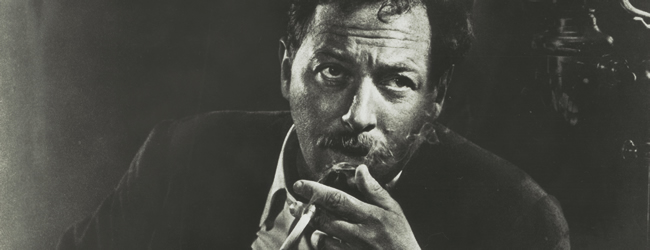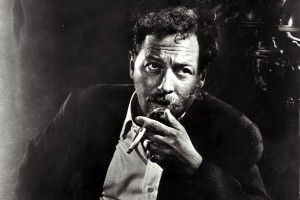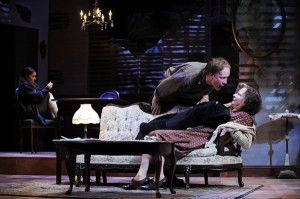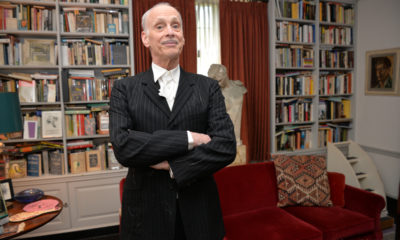Theater
America’s Bard
Legendary gay playwright Tennessee Williams honored in centennial festival


Tennessee Williams' homosexuality widely informed his work, often in coded ways. (Photo courtesy of the Tennessee Williams Papers, Rare Book and Manuscript Library, Columbia University)
He is the poet laureate of the American theater.
He pursued young men and boys with sexual voracity, especially hustlers, often rough trade, and those obsessively so in his latter years, but he also delighted greatly in the company of women.
His greatest creations on stage were in fact women, though some argue they were really coded figures who were actually gay males in drag. Certainly most of his heroines — especially perhaps Blanche DuBois in “A Streetcar named Desire” — were extensions of himself, valorous but doomed, haunted by desire, shadowed by failure, driven to despair and sometimes even to madness or to death.
He is Thomas Lanier Williams, born 100 years ago this weekend on Palm Sunday, March 26, 1911, in Columbus, Miss., to Edwina and Cornelius Williams. He was reared in an Episcopal rectory there, where his grandfather, Rev. Walter Dakin, was the local Episcopal priest, and later changed his name to “Tennessee” in honor of that same grandfather, who was born in that state.
Williams’ sense of sin and salvation in sexuality was central to his inner drives, says Derek Goldman, artistic director of this weekend’s Tennessee Williams Centennial Festival, a raft of plays and staged readings and panel discussions featuring appearances by among others Edward Albee and John Waters (Visit performingarts.georgetown.edu/tenncentfest/festival/ for details). For a long time, Williams was closeted about being gay, though he let it be known to his friends. Goldman says that though Williams had a long-time love relationship with his life partner Frankie Merlo, he was also “very promiscuous, and slept around a lot,” when “his need was for several boys a day at times, and the younger and prettier the better.”

Georgetown University's production of 'Glass Menagerie,' one of Tennessee Williams' most famous works. From left are recent alumni Rachel Caywood and Clark Young with Prof. Sarah Marshall. (Photo by Sue Kessler, courtesy of Georgetown University)
In his writing, however, Goldman says, the thirst to slake his need for for constant sexual consummation, took a different form through sublimation, because in his writing, he “explores not so much the sex but how those desires have a place in society” — or do not. Goldman is also associate professor of theater and performance studies at Georgetown University, where the Williams Festival — known for short as “Tenn Cent Fest” — is housed, and he directs the university’s Davis Performing Arts Center. Goldman says the festival, most of which runs from today through Sunday, has “certainly been a labor of love,” including being able to teach a seminar on Williams work and “for this past year” he says he has been “steeped in all things Williams.”
Goldman’s own first encounter with Williams came on cable TV, however, when he was about 13 and saw the film adaptations of “Streetcar Named Desire” (1951,) and “Cat on a Hot Tin Roof” (1958). In each case, of course, Hollywood producers insisted in excisions, and Goldman admits that “I now blush at the fact that they were so sanitized, taking much of the sexuality out.”
For example, Goldman points out that in the original version of “Cat” (which was on Broadway in 1955 when it was directed by Elia Kazan and won the Pulitzer Prize for Drama), it’s clear that Brick (first played by the actor Ben Gazzara) is actually bisexual, or even gay, as he admits to his feelings for his pro football buddy Skipper who has committed suicide. Goldman says that “the back story for Brick is his relationship with Skipper,” and that while Brick’s “sexuality is pretty complicated,” he has certainly “lost interest in Maggie sexually,” and “we understand that he definitely has homosexual desires.”
We, of course, mainly know Williams from his work. That is the only reason he rates such a “Tenn Cent Fest” weekend, more than a quarter century after his death, as Goldman is now curating. But behind and beneath that work was always his beating heart. Reading his private writing shows him “so emotionally naked, as he was working out his own stuff,” Goldman says.
“It shows the undulation between guilt and shame (at being gay), not being accepted for who he really was, and also being able to claim it with pride,” Goldman says. “It was not just one thing. It was a stew of contradictions pulsing back and forth in private.”
In one of Williams’ one-act plays, “Suddenly, Last Summer,” that opened off-Broadway in 1958 as part of a double-bill titled “In The Garden District,” the play is basically two long monologues, considered one of his starkest and most poetic works. Best known from the 1959 film adaptation, it is a mystery melodrama about why Catherine (Elizabeth Taylor in the film) has been institutionalized for severe emotional disturbance, the result of the violent death of her cousin Sebastian by dismemberment and cannibalism by local boys, the objects of his predatory sexual desire, she had witnessed during their trip to Spain. Sebastian’s wealthy mother, Violet Venable (Katharine Hepburn) is determined to hide the exact circumstances of her son’s death and the fact that he was gay.
Maya Roth, Georgetown’s director of theater and performance studies, is directing “Suddenly, Last Summer” at the Davis Performing Arts Center April 7-16. “It is a play about violence against homosexual men,” she says. “It’s about Sebastian,” who is never seen, except at a distance in memory, “and his queerness that can’t be mentioned, the love that dare not speak its name, that’s what ‘Suddenly, Last Summer’ is about.” Though sanitized in the film version, it was written as one of his early plays but for a long time remained unproduced. When it was finally presented on stage, it was a kind of “coming out” for Williams, she says, “and it was really radical, and the reason why Hollywood had to airbrush it out.”
Asked about the legacy of Williams — his many plays as well as novels and short stories and occasional screenplays — Goldman says, “it’s more than a legacy, it’s the urgency still in his work, because it’s still very fresh,” in what he calls its “incredible lyricism and heat, the poetry of its fierce and ferocious imagery, in its language as windows into the soul.”
“He’s the poet of the vulnerable, whose compassion is in the size of his tenderness and faith in the beauty of the broken, those who have suffered the collateral damages of a world that doesn’t celebrate individuality, that doesn’t make allowances for the beauty of the broken,” Goldman says. “He’s the one who pierces the heart and the intellect, but it’s the heart, the emotional connection that we have to his work, that is most indelible.”
“He’s our American Shakespeare,” Goldman says, “combining the elevation of lyricism and magician-ship of language with the power of great story-telling,” and for Goldman, of all of Williams’ work there stands what he calls “the holy trinity,” his own “personal pantheon” of Williams’ three greatest creations: “The Glass Menagerie” (1944), “Streetcar Named Desire” (1948) and “Camino Real” (1953). The latter is being performed in a staged reading directed by Goldman tonight at 7:45 p.m.
Theater
Astounding ‘LIZZIE’ builds on legendary axe murder tale
Rock musical twist addresses abuse, oppression, queer identity

‘LIZZIE’
Through Nov. 30
Keegan Theatre
1742 Church St., N.W.
$54-$65
Keegantheatre.com
Lizzie Borden put Fall River, Mass., on the map. When the 32-year-old, seemingly respectable woman was charged with the axe murder of her father Andrew and stepmother Abby in the summer of 1892, it sent shock waves across the community and far beyond.
In time, the gruesome tale would weave its way into the annals of American crime lore, always remembered through that popular nursery rhyme “Lizzie Borden took an axe, gave her father 40 whacks…” Well, you know the rest.
The astoundingly terrific “LIZZIE” (now playing at Keegan Theatre, a short walk from Dupont Circle Metro) builds on the legend. The rock musical with book by Tim Maner, music by Steven Cheslik-deMeyer and Alan Stevens Hewitt, and lyrics by Cheslik-deMeyer and Maner, follows the days leading up to the grisly murders (unseen offstage) through Lizzie’s acquittal, bringing to the fore matters of abuse, oppression, and queer identity.
Shrewdly staged and choreographed by Jennifer J. Hopkins, the show begins with a haunting version of “Forty Whacks (Prologue),” featuring the talented cast of four women who can sing, act, move, and deliver the occasional laugh-out-loud line.
Clearly, frustrated Lizzie (powerfully played by Caroline Graham) and dominant older sister Emma (Sydne Lyon), both unmarried and still at home, are angsty and deeply unhappy. They resent their father for a litany of reasons including his extreme Yankee frugality. While one of the richest men in Fall River, he chooses to live on a sad street and go without indoor plumbing rather than set up housekeeping in posh digs across town. But it’s when they see Andrew’s great fortune slipping away to their stepmother that their fury reaches new heights.
Much of “LIZZIE” takes place at the scene of the crime, the Borden residence – cleverly suggested by scenic designer Josh Sticklin with some clapboard siding, stairways, a bit of period wallpaper and a purposely incongruous, large Borden family coat of arms.
Lighting designer Sage Green, convincingly and evocatively, summons at turns a bona fide rock concert experience, dimly lit parlor, or an intimate setting in a small yard.
And costume designer Logan Benson savvily adds to the atmosphere. Lizzie’s somber dresses with their accurate to the era leg-of-mutton sleeves give way to something altogether glitzier and more revealing after the murders.
There is dialogue, but the Riot Grrrl-inspired work is mostly sung through with punk rock anthems, ballads, and character driven songs. Whether spoken or sung, “LIZZIE” makes no bones about the title character’s guilt while introducing varying levels of collusion among the other women.
A knowing wry smirk from the house maid Bridget (Brigid Wallace Harper) says a lot about the family dynamic (“there’s a lock on every door / In every room a prisoner of a long, silent war”) as well as what went down that summer morning at the Borden house.
Lizzie’s secret girlfriend Alice (golden throated Savannah Blackwell) who conveniently lives next door, is besotted and watches her every move. Just after the murders, she saw Lizzie burn a dress in the yard.
The hard driving score is played by a passionate half-dozen strong band led by Marika Countouris. Sometimes, the instruments overpower the amplified singers and a lyric or two is lost, but that’s not so unusual with rock musicals.
At 90 minutes with a leisurely intermission (well-earned by the band and cast, especially Graham as Lizzie who’s onstage throughout, often incorporating frenetic movement and strenuous air guitar into her many songs), the first half explores feelings of entrapment and the second liberation.
Lizzie goes to trial. Despite a shaky alibi, the defendant seems to be winning over the jury. Looks like she might get that grand house on the hill after all.
The Borden story has been shared in varied ways including innumerable books and documentaries, Jack Beeson’s opera “Lizzie Borden” (1965), Agnes de Mille’s ballet “Fall River Legend” (1954), and the memorable 1975 TV movie starring Elizabeth Montgomery (best known as the perky reluctant witch Samantha Stevens on TV’s sitcom “Bewitched”) playing against type.
Today, the legend endures with “LIZZIE” at Keegan.
Theater
Reggie White explores the many definitions of home in ‘Fremont Ave.’
‘Music and humor set against the rhythm of a cutthroat game of spades’

‘Fremont Ave.’
Through Nov. 23
Arena Stage
1101 Sixth St., S.W.
Tickets start at $49
Arenastage.org
For Reggie D. White, growing up Black and queer in the late 1980s and early ‘90s, there wasn’t a lot of vocabulary for his experience outside of the AIDS crisis. Despite being surrounded by family who loved him, White felt isolated in his own home; there was a sort of membrane that prevented him from being present.
With his new play “Fremont Ave.,” now running at Arena Stage, White has written a work about home and the many definitions of that idea specifically relating to three generations of Black men.
Set in a house on a street in a Southern California suburb (similar to where White grew up), “Fremont Ave.” explores the ways a lack of belonging can be passed down generationally. The first act is boy meets girl and creating a home; and the second watches the next generation struggling to achieve something different.
“The third act’s storyline is deeply queer,” White explains. “Boyfriends Joseph and Damon have been together for years yet can’t figure out what it means to make a home. We don’t totally see the relationship solved, but there’s a glimmer of hope that it just might make it.”
The playwright notes, it’s not all about familial angst and alienation: “Much of the play is music and humor set against the rhythm of a cutthroat game of spades.”
Playwright, actor, and educator, White “does all the things.” Currently, he holds the title of Arena’s senior director of artistic strategy & impact, a role focused on artistic vision and growth. Superbly energetic, White splits his time between Arena and his prized rent-stabilized residence in Brooklyn’s desirable Park Slope neighborhood. He’s already told his landlord that he’s never leaving.
At seven, he came close to landing the part of young Simba in the pre-Broadway “Lion King.” Soured by the near miss, White turned his attention to sports and studies. In his freshman year at college in the Bay Area, he took a musical theater class for the heck of it, and soon gave up law school ambitions to focus on show biz. He went on to appear in Matthew López’s Broadway success “The Inheritance” until the pandemic hit.
Winning the Colman Domingo Award in 2021 gave White the flexibility to write “Fremont Ave.” (The award is given to a Black male or male-identifying theater artist and includes a cash stipend and development opportunities.)
“It can be scary to make a career in the arts. I ran from it for a long time. Then one morning I just woke up very grateful for the accumulation of accidental circumstances that landed me in this moment.”
WASHINGTON BLADE: Is queerness your secret to success?
REGGIE D. WHITE: I’m not saying that being queer is my mutant super power, but I do think there is an element of living my life on the margins trying to find a place for myself that I’ve been able to observe relationships and how people engage and interact with each other that gives me a real objective eye on how to render a world that I didn’t live in.
BLADE: What’s queer about your work?
WHITE: There’s this thing that James Baldwin said a lot, it’s about being on the outside of an experience, being able to observe more astutely. With “Fremont Ave.” it felt important to me that the actor leading us through is played by a queer actor. I wanted that authenticity and that experience of having felt isolation.
It’s unique that the central man in each story, the grandfather, stepson, and grandson are played by the same queer actor Bradley Gibson, that amazing TV star with the big muscles.
It’s also interesting to watch a single body traverse over generations in the same house (altered over time by appliance and art updates).
BLADE: Premiering your play as part of Arena’s 75th anniversary season must be a thrill.
WHITE: Sometimes I ask myself, how is this happening? And I didn’t even have to sleep with anybody. But seriously, I’m lucky. Arena excels at taking great care of world premieres, and the production’s director Lili-Anne Brown has a visceral sense of how to create community and life on stage.
BLADE: What else is unique about “Fremont Ave.”?
WHITE: Men aren’t a particularly emotionally literate species, so there haven’t been a lot of plays exploring the emotional condition of men and what it means to learn to love.
For men, love looks like silence. I wanted to explore what it looks like when there’s a deep curiosity about the people we’ve known and loved.
BLADE: Was risk involved?
WHITE: I wrote a deeply personal play. That’s scary. So, to see everyone involved invest their own love into what’s my play, that’s incredible, and a great confirmation of “specificity is the key to universality.” People seeing themselves in the characters has been both beautiful and surprising.
Theater
Set designer August Henney puts new spin on Mary Shelley’s life
‘So Late Into the Night’ an ideal fall show at Rorschach

‘So Late Into the Night’
Through Nov. 2
Rorschach Theatre
The Stacks @ Buzzard Point
101 V St., S.W.
Spooky Action Theater
Washington, D.C.
Tickets start at $74
Rorshachtheatre.com
We’ve all been to that scary party or two. But ordinarily, it’s not by choice.
But with playwright Shawn Northrip’s So Late Into the Night, the spookiness is planned, executed, and fun. Northrip lays out the story of novelist Mary Wollstonecraft Shelley, famed author of the gothic masterpiece Frankenstein, and in gathering her Romantic poet friends and lovers, investigates their afterlife.
What’s more, the new play, which also features a rock séance, is performed in the Stacks at D.C.’s Buzzard Point neighborhood, a unique neighborhood positioned where the Potomac and Anacostia Rivers meet, just south of Audi Field.
At the Stacks, Rorschach is activating a high-ceilinged corner retail that serves as the company’s fall home base. Inside the cavernous space, the production’s set designer August Henney is putting a new spin on Newstead Abbey, the grand home of Lord Byron, a friend of Shelley. Included in the new look are a Victorian dining table (33 by 12 feet), grand drapes, and modern rock and roll posters. Audience members can sit at the table or the risers on the perimeter.
Henney, who identifies as a trans gay man, is a Bay Area transplant who arrived in D.C. three years ago to study scenic design at the University of Maryland. The experience has been transformational.
WASHINGTON BLADE: How do you pursue concept before realizing a set?
AUGUST HENNEY: At first, I go through the script and take out words that spark inspiration. I’m very much a words person – I find words and then relatable images. Next, I create a collage and present it to the director.
BLADE: Along the way, does the director exert control?
HENNEY: Oh yes. It’s hopefully conversation, but they have the final say about everything. If it’s very important to me or I think it’s very important to the show, I’ll fight for it.
BLADE: When the show kicks off does your vision typically come to fruition.
HENNEY: That depends entirely on the technical director. I do the drafting and present it to the tech director. Lays out how to do that. Like an engineer and architect. This is how I want the façade to look but I don’t care so much about the insides. Comes down to what we can and can’t do. Usually comes down to cost.
BLADE: How much was learned in life and now much at school?
HENNEY: At school, I came in not knowing much. UMD cleverly matched us up with a cohort who has different skills from you. They do that well. So, there were endless hours in the hallways of the grad school where we’d build models until 3 a.m. working and blasting music. I also learned from my father who is adept at wood working, and jobs in prop shops.
BLADE: How was your coming out as a trans gay man?
Henney: Well grad school really helped with that. I believe the universe puts people in places. And with UMD, it put me in the right place. At undergrad, I got another degree in human physiology and thought I wanted to be a doctor for a second. My path would have been very different.
Scenic design placed me in range of the right people who helped me realize things about myself that I didn’t have to keep hiding. Theater is such an inclusive community already and I feel safe here while the world is so unsafe.
BLADE: This morning, I heard the administration was blaming the government shutdown on trans people. Does that kind of madness get you angry?
HENNEY: Angry, frustrated, and despondent. I get through the days by focusing on the good bits, and the people who make me feel like myself. That’s all you can really hope for in a world that’s falling apart.
BLADE: Yet, the show goes on.
HENNEY: Oh yes, and So Late Into the Night is a wonderful show. It pairs with some of the best things in the world like spooky ghost stories and dramatic rock music in autumn, the perfect season. It’s a show where audience members can feasibly be seated next to Mary Shelley and friends at a big dining table on Halloween night. How great is that?
-

 District of Columbia3 days ago
District of Columbia3 days ago‘Sandwich guy’ not guilty in assault case
-

 Sports3 days ago
Sports3 days agoGay speedskater racing toward a more inclusive future in sports
-

 New Jersey4 days ago
New Jersey4 days agoBlue wave hits Northeast: Sherrill and Mamdani lead Democratic comeback
-

 District of Columbia4 days ago
District of Columbia4 days agoTrial begins for man charged with throwing sandwich at federal agent


















